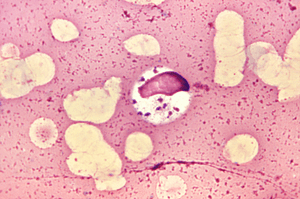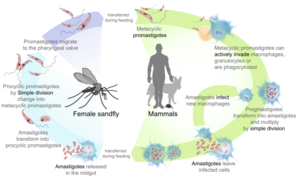Leishmania facts for kids
Quick facts for kids Leishmania |
|
|---|---|
 |
|
| L. donovanii in bone marrow cell | |
| Scientific classification | |
| Kingdom: | |
| Phylum: | |
| Class: | |
| Order: | |
| Family: | |
| Genus: |
Leishmania
|
Leishmania are tiny living things called protists. They are a type of parasite that can cause a disease called Leishmaniasis. These parasites belong to a group called Euglenozoa.
Leishmania parasites are spread by sandflies. In some parts of the world, like Europe, Asia, and Africa, the sandflies are from the Phlebotomus group. In North and South America, they are from the Lutzomyia group.
These parasites mainly live inside vertebrates. They often infect animals like hyraxes, dogs, and rodents. Humans can also get infected. Currently, about 12 million people in 98 countries are affected by Leishmania. The parasite was named in 1903 after a Scottish scientist, William Boog Leishman.
Contents
What Diseases Does Leishmania Cause?
Leishmania parasites can cause three main types of diseases. Different kinds of Leishmania cause each type of disease.
- Skin Disease: This type causes sores on the skin, sometimes called "Oriental sore."
- Mucous Membrane Disease: This affects the soft, moist linings inside the body, like the nose or mouth. This form can be very serious.
- Organ Disease: This affects important internal organs like the liver and spleen. It can also lead to anemia, which means your body doesn't have enough healthy red blood cells. This severe form is sometimes called kala-azar.
How Leishmania is Built
Leishmania parasites have a special outer layer called a lipophosphoglycan coat. This coat helps them interact with the body they are infecting. It can trigger a part of the body's defense system, called the innate immune response.
Even though the body tries to fight back, the parasite is strong and can survive. Doctors have treatments that help the body's immune system respond better to the parasite.
Leishmania Life Cycle
The Leishmania parasite has a complex life cycle that involves two hosts: a sandfly and a vertebrate (like a human or animal).
1. In the Sandfly: When a sandfly bites an infected animal or person, it picks up the parasites. Inside the sandfly, the parasites change and multiply. 2. Infection: When the infected sandfly bites another animal or person, it passes the parasites into their skin. 3. In the Vertebrate: Once inside the new host, the parasites enter certain immune cells. They change form again and multiply inside these cells. 4. Spread: As the parasites multiply, they can spread to different parts of the body, causing the various forms of leishmaniasis. 5. New Infection: If another sandfly bites an infected person or animal, it picks up the parasites, and the cycle continues.
Images for kids
See also
 In Spanish: Leishmania para niños
In Spanish: Leishmania para niños




